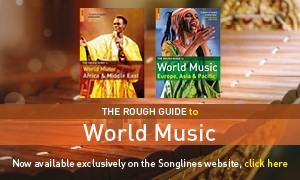Thursday, April 10, 2025
Rust’s Electro-Tarab: challenging Eurocentric narratives about Arabic music production
By Rim Irscheid
Rim Irscheid unpacks the stigma faced by Arabic diaspora musicians and how Syrian-Lebanese duo Rust are subverting expectations

Rust
In an era where classical Arabic music is often reduced to being a tool for cultural diplomacy or a commodity for world music markets, Rust, a duo comprised of Syrian oud player Hany Manja and Lebanese vocalist Petra Hawi, are redefining heritage-making in diaspora music. By drawing on mid-20th century Arabic vocal styles and aesthetics of modern electronic production methods, Rust’s music is informed by their history of migration and displacement. With their appreciation of Arabic modal (maqam) traditions, tarab (an emotional state of ecstasy) and wasla (a suite of instrumental and vocal pieces), the duo address static notions of musical heritage. In doing so, they challenge Eurocentric narratives about Arabic music production and its dependencies on the Western gaze.
Rust’s self-described genre, ‘electro-tarab’, encapsulates their approach to performance and composition. Tarab, a foundational principle of classical Arabic music, is a transformative emotional experience shared between performer and listener. Traditionally, it is cultivated through long, improvisational performances, most famously in the live concerts of Oum Kalthoum. In Jonathan Shannon’s book Emotion, Performance, and Temporality in Arab Music, an Aleppine vocalist describes tarab as “the feeling you get when you listen to music, and it just makes you want to say ‘ahh!’” Shannon goes on to say that tarab is a product of the music, performance aspects and participation of the audience. Rust reimagine tarab through electronic sound and vocal techniques, using electric oud and synthesizers.
For their first UK tour, Manja and Hawy studied the wasla, a complex musical suite found in classical Egyptian music. Typically, a concert would feature two or three waslas. By deconstructing the musical form of wasla into their melodic and rhythmic components, the duo reshape them for listeners while maintaining the core principles of tarab to evoke a similar emotional effect. To execute this, Manja engaged in what he called a “Western music detox”, spending six months listening exclusively to early and mid-20th-century Arabic music as a means to reconnect with classical Arabic music and find ways of adapting the music to the duo’s taste and skill sets.
Rust moved to Prague, Czech Republic, after the war on Gaza began in October 2023. Following the Syrian civil war and Lebanese economic collapse in 2019, political and economic crises changed many ways Arabic music and its performers are framed, perceived and included (or excluded) from European cultural landscapes. These developments also put heritage preservation into focus, and centred efforts to use narratives around multiculturalism of music festivals as a tool for institutions to showcase commitment to diversity. This is often done in ways that are, at best, short-lived and well-meaning initiatives and, at worst, tokenistic and harmful to performers.
When drawing on classical Arabic genres or vocal styles, musicians I spoke to during my research on Arab musicianship in Germany said they felt “not experimental enough” by the standards of the contemporary music scene when they do not conform to Eurocentric ideas of modernity (i.e. beat-driven electronic music or free improv). They likewise felt “too experimental” when deconstructing classical Arabic instrumental forms using electronic production methods. Both these approaches centre the discussion of Arabic music as one that privileges the white European gaze, mediated for markets and consumers that seek authentic experiences and display their tolerance towards Arabic arts and culture. Rust challenge these binaries by positioning themselves as both invested in heritage preservation and able to experiment beyond historical context on their own terms. For example, their choice to sing in the Egyptian dialect is historically informed and personal. Given Egypt’s role as the region’s musical hub during the mid-20th century, singing in Egyptian Arabic pays homage to that legacy while also reflecting the broader pan-Arab heritage that Rust draws on.
With musical productions and outreach programmes that focus on music pedagogy and principles of community care, such as the Beirut Synth Center that Manja co-founded in Lebanon, the duo challenge two dominant narratives that often frame Arabic musicians in the diaspora: either as victims whose music expresses nostalgia and longing for a homeland, or as traditionalists who must adapt their sound to fit Western expectations of progress. Rust reject both extremes, instead creating an aesthetic where the wasla is seen as an evolving and adaptable musical tradition rather than a static element of classical composition. Their approach highlights the agency of Arabic musicians in shaping their own artistic directions, rather than conforming to Western expectations of what Arabic music should be. In doing so, Rust’s music speaks simultaneously to Arabic-speaking listeners who recognise the nostalgic elements in their compositions and to non-Arabic audiences interested in discovering traditional musical structures in a new way.
Manja and Hawy are two of many examples of diaspora musicians proving that tradition is not frozen in time but adapts, alters and moves with the people who carry it. In the context of displacement, exile and war, their compositions offer not just a way of looking backwards but a pathway to new musical futures that remain rooted while unafraid to evolve. “We aimed to preserve the essence of the original compositions while adding our own touch and vision”, they explain.

